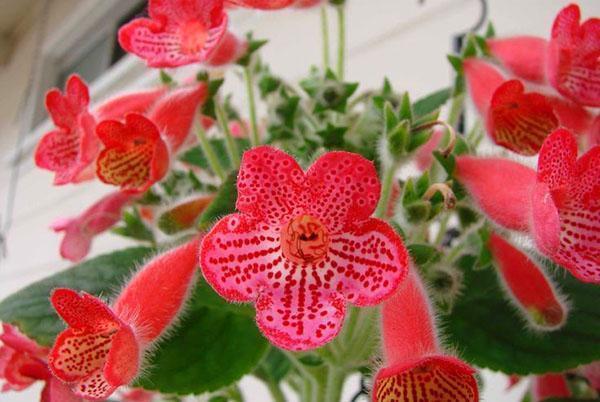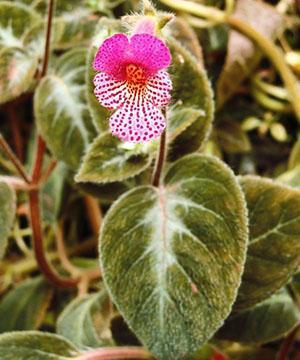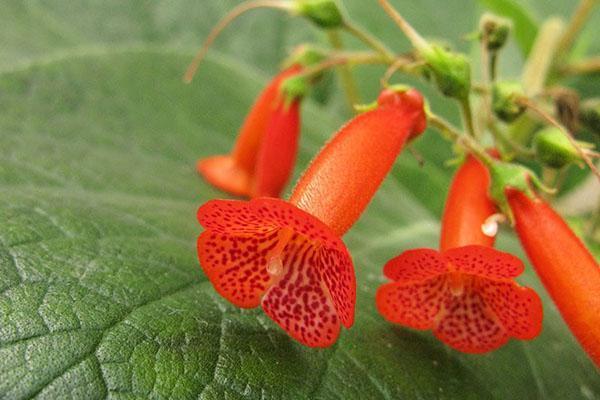What kind of care does colliery need at home
 Many Gesneriaceae are grown as flowering indoor plants. These types also include collieria, home care for which will not cause serious trouble, but another green exhibit with bright flowers-bells will appear in the collection.
Many Gesneriaceae are grown as flowering indoor plants. These types also include collieria, home care for which will not cause serious trouble, but another green exhibit with bright flowers-bells will appear in the collection.
In nature, the plant belonging to the Gesneriev family lives in the tropical regions of Central and South America. This is a perennial herbaceous shrub with thin, almost unbranched shoots, pubescent foliage and velvety tubular bells, which can delight the grower almost all year round.
Features of the color scheme in the photo and in the description
Ovate-pointed leaves sit oppositely on the shoots and, depending on the species and variety, can be not only green, but also purple, bluish or almost purple. Flowers in koleriya, as in the photo, are predominantly red and orange. But there are varieties with purple or pink bells. Variegated, speckled corollas are not uncommon. Flowers up to 4 cm in diameter are formed at the tops of the stems and are held on long peduncles.
If a competent regular care is established for the plant, colliery at home responds with massive flowering, when 15-20 flowers open on one bush at a time.
Unlike the next of kin gloxiniaforming tubers, a thickened scaly rhizome forms under the soil cover.
Types of coleria: photos of indoor crops

- in the size of the crown;
- in the color of foliage and flowers;
- in the place of growth in natural conditions.
Coleria pleasant or Kohleria amabilis stands out with a dark green or brownish foliage with a silvery thick pile. Stems, cuttings and veins have a purple hue. On the peduncles, one, two or less often three flowers are revealed. The color of the corollas can range from pale pink or orange to crimson. In the type of koleria shown in the photo, it is not uncommon for two-colored corollas with a variegated, speckled pharynx.
 Coleria fluffy or Kohleria eriantha is most often found indoors. Plants are easily recognizable by their olive green pubescent leaves, which appear brown due to the reddish hairs along the edges. The flowers of this type of color, as in the photo, have a predominantly bright orange-red color. In the mouth of the bell, the shade changes to yellow. Red or burgundy spots are scattered over the petals. Several flowers are revealed on the peduncles at once.
Coleria fluffy or Kohleria eriantha is most often found indoors. Plants are easily recognizable by their olive green pubescent leaves, which appear brown due to the reddish hairs along the edges. The flowers of this type of color, as in the photo, have a predominantly bright orange-red color. In the mouth of the bell, the shade changes to yellow. Red or burgundy spots are scattered over the petals. Several flowers are revealed on the peduncles at once.
 Koleria bogotá, Kohleria bogotensis or, in the alternative opinion of botanists, Kohleria amabilis var. Bogotensis, can be recognized by green downy leaves and red-yellow flowers with burgundy specks on the inner surface of the petals and throat.
Koleria bogotá, Kohleria bogotensis or, in the alternative opinion of botanists, Kohleria amabilis var. Bogotensis, can be recognized by green downy leaves and red-yellow flowers with burgundy specks on the inner surface of the petals and throat.
 In addition to a variety with an even green color of foliage, there are specimens of this type of coleria, as in the photo, striking the imagination of a grower with dark, brown-green foliage and the same shoots.
In addition to a variety with an even green color of foliage, there are specimens of this type of coleria, as in the photo, striking the imagination of a grower with dark, brown-green foliage and the same shoots.
Coleria Varshevich or Kohleria warszewiczii is another plant species that deserves the attention of indoor plant lovers. This large variety of coleria has:
- rather dense erect stems of a dark green color;
- pointed elliptical leaves;
- unusual flowers with a lilac or pinkish tube and light yellow-green petals covered with purple or brownish specks.
 A different name for the species shown in the photo is often used - foxglove coleria or Kohleria digitaliflora.
A different name for the species shown in the photo is often used - foxglove coleria or Kohleria digitaliflora.
Home care for koleriya
 Coleria is one of the most unpretentious plants in the family. It grows and blooms without any problems at room temperatures. Culture loves light, but in the hot sun it can wither, lose its decorative effect and drop flowers ahead of time, therefore, it is better to provide shading on the southern windows at midday. With a shortage of sunlight, the shoots stretch out, become disproportionately thin and weakened. The leaves are shrinking, flowering is not pleasing in mass.
Coleria is one of the most unpretentious plants in the family. It grows and blooms without any problems at room temperatures. Culture loves light, but in the hot sun it can wither, lose its decorative effect and drop flowers ahead of time, therefore, it is better to provide shading on the southern windows at midday. With a shortage of sunlight, the shoots stretch out, become disproportionately thin and weakened. The leaves are shrinking, flowering is not pleasing in mass.
In the cold season, many plants shed their leaves, complete flowering, and over time, their entire aerial part dies off. In this case, it is better to lower the air temperature by 5–7 ° C and reduce watering, only occasionally moistening the soil. In the spring, when the roots show signs of awakening, the pots are exposed to the light and resume the previous care of the color scheme.
 If for the winter koleria, as in the photo, preserves foliage, it still needs light, regular, but not as abundant as watering in summer and a temperature of 16-18 ° C.
If for the winter koleria, as in the photo, preserves foliage, it still needs light, regular, but not as abundant as watering in summer and a temperature of 16-18 ° C.
In addition to watering and maintaining an optimal temperature, home care for your paintwork includes measures to humidify the air, which is especially useful on hot days and when the heating is running.
 In the spring, koleria are transplanted into nutritious loose soil. To do this, take a ready-made mixture for Saintpaulias or a universal substrate for flowering crops. Since the rhizomes of the plant are shallow below the surface, it is better to choose wide, not too deep containers, at the bottom of which drainage must be arranged.
In the spring, koleria are transplanted into nutritious loose soil. To do this, take a ready-made mixture for Saintpaulias or a universal substrate for flowering crops. Since the rhizomes of the plant are shallow below the surface, it is better to choose wide, not too deep containers, at the bottom of which drainage must be arranged.
 The transplant is used to propagate colerias with parts of the rhizome. Small fragments with several dormant buds are separated from the mother plant, dried and dropped into the ground to a depth of 2 cm. After that, you just need to moisten the soil. And when sprouts appear above its surface, they begin systematic care of the color scheme, including monthly feedinglasting until autumn.
The transplant is used to propagate colerias with parts of the rhizome. Small fragments with several dormant buds are separated from the mother plant, dried and dropped into the ground to a depth of 2 cm. After that, you just need to moisten the soil. And when sprouts appear above its surface, they begin systematic care of the color scheme, including monthly feedinglasting until autumn.
An obligatory stage in caring for a color scheme at home is crown formation. It consists in the pinching of the growing and lying shoots. Apex removal stimulates:
- awakening of the axillary kidneys;
- branching;
- the formation of new buds on the lateral shoots.
Cuttings obtained during the pinching can be rooted in water or in a substrate, thus obtaining not only a compact flowering plant, but also new young coleria of a favorite species.
When a pair of adult leaves appears on a small bush, the top is pinched again to start crown formation. If the formation is not carried out, in most types of coleria, shoots lodge, turning the plant into ampelous.